Learn about the best hanging plants to grow in 2024 with our top 20 list. Discover plants that are easy to care for and perfect for any space.
Are you looking to add some greenery to your space but short on floor space? Hanging plants might be the perfect solution! They’re not only beautiful but also great space-savers. In this article, we’ll explore the top 20 best hanging plants to grow in 2024. Whether you’re a seasoned plant parent or just starting out, there’s something here for everyone.
Why Choose Hanging Plants?
Before we dive into our list, let’s talk about why hanging plants are so great:
- Space-saving: Perfect for small apartments or crowded rooms.
- Eye-catching: They add visual interest at different heights.
- Air-purifying: Many hanging plants help clean the air in your home.
- Versatile: Can be hung indoors or outdoors, depending on the plant.
Now, let’s get to our top 20 list!
1. Pothos
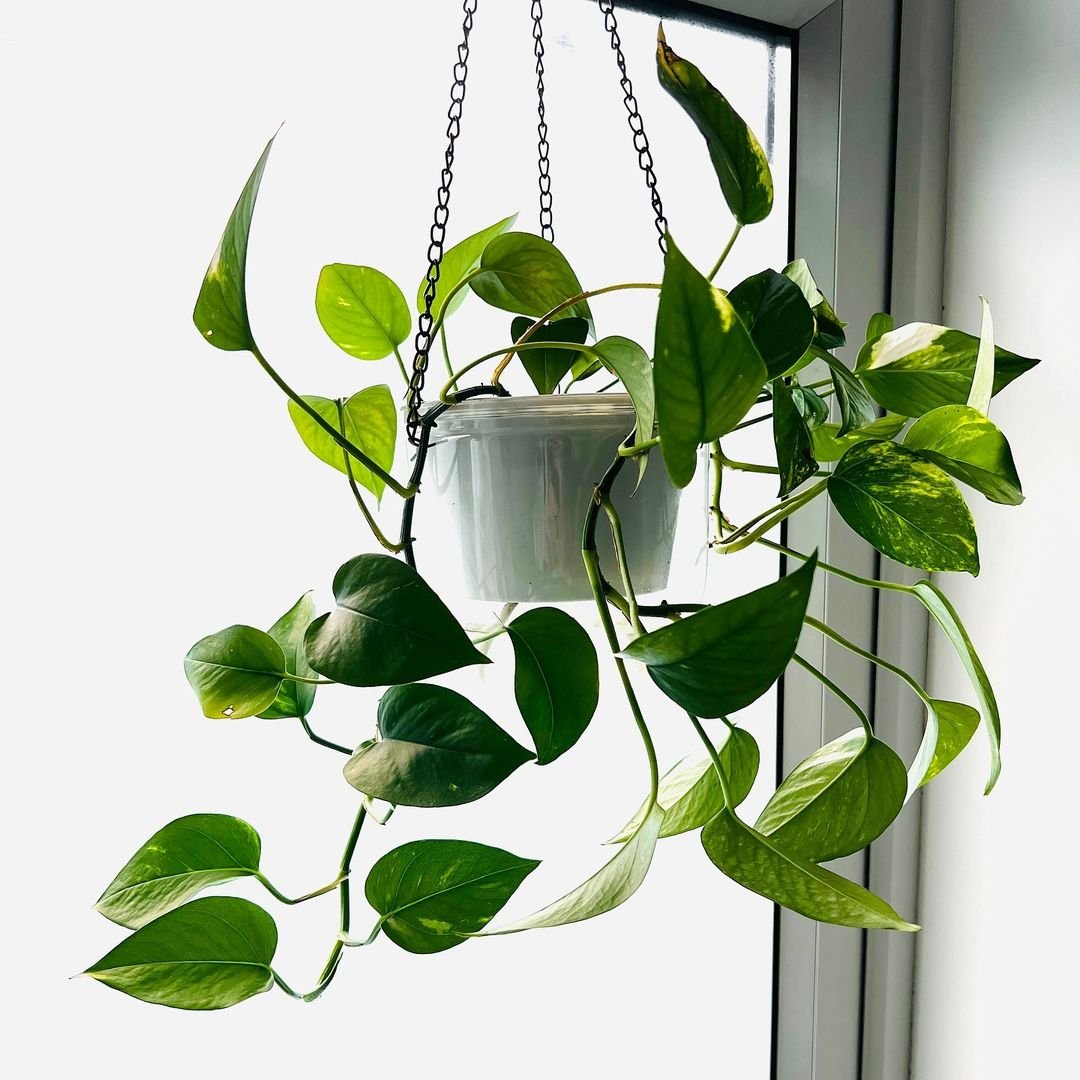
Here’s an easy and verified chart for Pothos Plant (Epipremnum aureum):
| Category | Details |
|---|---|
| Botanical Name | Epipremnum aureum |
| Common Name | Pothos, Devil’s Ivy |
| Plant Name | Pothos |
| Zone | Zones 10-12 (outdoors); can be grown indoors in all zones |
| Sun Exposure | Indirect light to low light; avoid direct sunlight |
| Soil Type | Well-draining, potting mix |
| Watering | Allow top inch of soil to dry out between waterings; moderately drought-tolerant |
| Growth Habit | Evergreen vine |
| Height/Spread | Vining habit, can grow up to 10 feet or more indoors; outdoors can spread extensively |
| Special Features | Attractive, heart-shaped leaves that are often variegated; low maintenance; good air purifier; can be trained to climb or allowed to trail; ideal for hanging baskets, shelves or trellises; tolerant of a wide range of conditions; easy to propagate from cuttings |
Pothos is often called the “cubicle plant” because it’s so easy to grow. It’s a great choice for beginners.
Care tips:
- Light: Tolerates low to bright indirect light
- Water: Allow soil to dry between waterings
- Humidity: Adapts to average home humidity
2. Spider Plant

Here’s a detailed and verified information chart for the Spider Plant:
| Category | Details |
|---|---|
| Botanical Name | Chlorophytum comosum |
| Common Name | Spider Plant, Airplane Plant |
| Plant Name | Spider Plant |
| Zone | USDA zones 9-11 |
| Sun Exposure | Bright, indirect light |
| Soil Type | Well-draining, loamy soil |
| Watering | Moderate; keep soil evenly moist |
| Growth Habit | Arching, clump-forming |
| Height/Spread | 12-15 inches tall and wide |
| Special Features | Air-purifying, easy to grow, tolerates neglect |
Spider plants are known for their arching leaves and little “babies” that dangle down.
Care tips:
- Light: Bright indirect light
- Water: Keep soil lightly moist
- Humidity: Average to high
Learn more about Spider Plant care
3. English Ivy

Here is an information chart for English Ivy:
| Category | Details |
|---|---|
| Botanical Name | Hedera helix |
| Common Name | English Ivy |
| Plant Name | English Ivy |
| Zone | USDA zones 4-9 |
| Sun Exposure | Full sun to partial shade |
| Soil Type | Well-draining, fertile soil |
| Watering | Moderate; keep soil evenly moist |
| Growth Habit | Climbing or trailing vine |
| Height/Spread | Can grow up to 50 feet long |
| Special Features | Evergreen, air-purifying, invasive in some areas |
English Ivy is a classic hanging plant with elegant, trailing vines.
Care tips:
- Light: Bright indirect light
- Water: Keep soil slightly moist
- Humidity: Prefers high humidity
Learn more about English Ivy care
4. String of Pearls
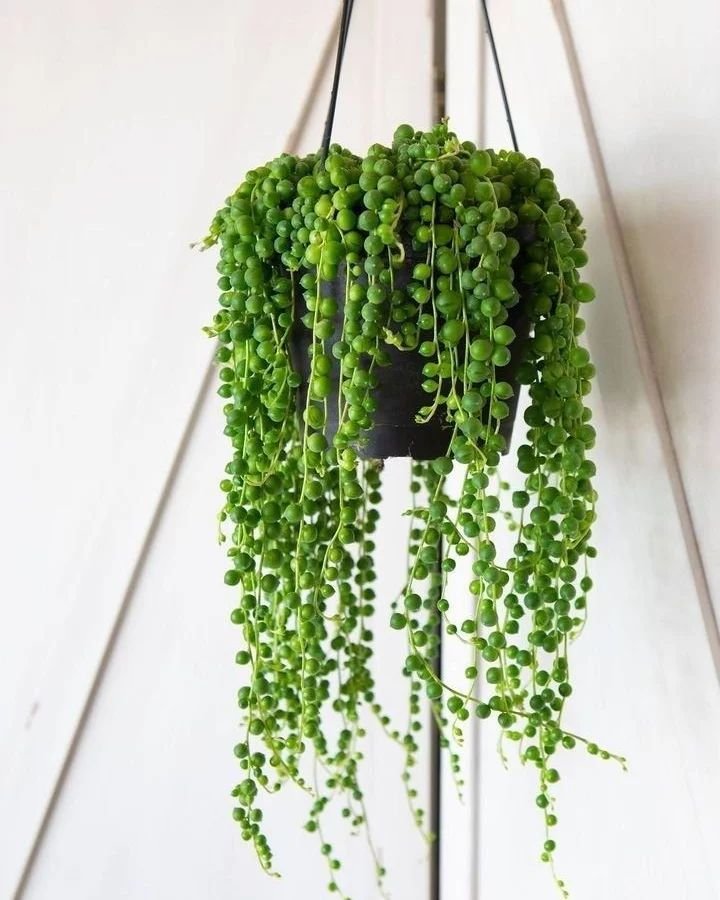
Here is an information chart for the String of Pearls plant:
| Category | Details |
|---|---|
| Botanical Name | Senecio rowleyanus |
| Common Name | String of Pearls, String of Beads |
| Plant Name | String of Pearls |
| Zone | USDA zones 9-12 |
| Sun Exposure | Bright, indirect light |
| Soil Type | Well-draining, sandy soil |
| Watering | Infrequent; allow soil to dry out between waterings |
| Growth Habit | Trailing succulent |
| Height/Spread | 2-3 feet long trailing stems |
| Special Features | Drought-tolerant, easy to propagate, unique bead-like appearance |
This unique succulent looks like a string of little green beads.
Care tips:
- Light: Bright indirect light
- Water: Allow soil to dry between waterings
- Humidity: Low to average
Learn more about String of Pearls care
5. Boston Fern

Here is an information chart for the Boston Fern:
| Category | Details |
|---|---|
| Botanical Name | Nephrolepis exaltata |
| Common Name | Boston Fern |
| Plant Name | Boston Fern |
| Zone | USDA zones 9-11 |
| Sun Exposure | Indirect light to partial shade |
| Soil Type | Well-draining, rich and moist soil |
| Watering | Consistent moisture; do not let dry out |
| Growth Habit | Arching, bushy |
| Height/Spread | 1-3 feet tall, 1-3 feet wide |
| Special Features | Air-purifying, pet-friendly, lush foliage |
Boston Ferns are known for their lush, feathery fronds.
Care tips:
- Light: Bright indirect light
- Water: Keep soil consistently moist
- Humidity: High
Learn more about Boston Fern care
6. Burro’s Tail

Here is an information chart for Burro’s Tail:
| Category | Details |
|---|---|
| Botanical Name | Sedum morganianum |
| Common Name | Burro’s Tail, Donkey’s Tail |
| Plant Name | Burro’s Tail |
| Zone | USDA zones 9-11 |
| Sun Exposure | Bright, indirect light to partial sun |
| Soil Type | Well-draining, sandy or cactus mix |
| Watering | Infrequent; allow soil to dry out between waterings |
| Growth Habit | Trailing succulent |
| Height/Spread | 1-4 feet long trailing stems |
| Special Features | Drought-tolerant, unique trailing foliage, easy to propagate |
This succulent has long, trailing stems covered in plump, blue-green leaves.
Care tips:
- Light: Bright indirect light
- Water: Allow soil to dry between waterings
- Humidity: Low
Learn more about Burro’s Tail care
7. String of Hearts
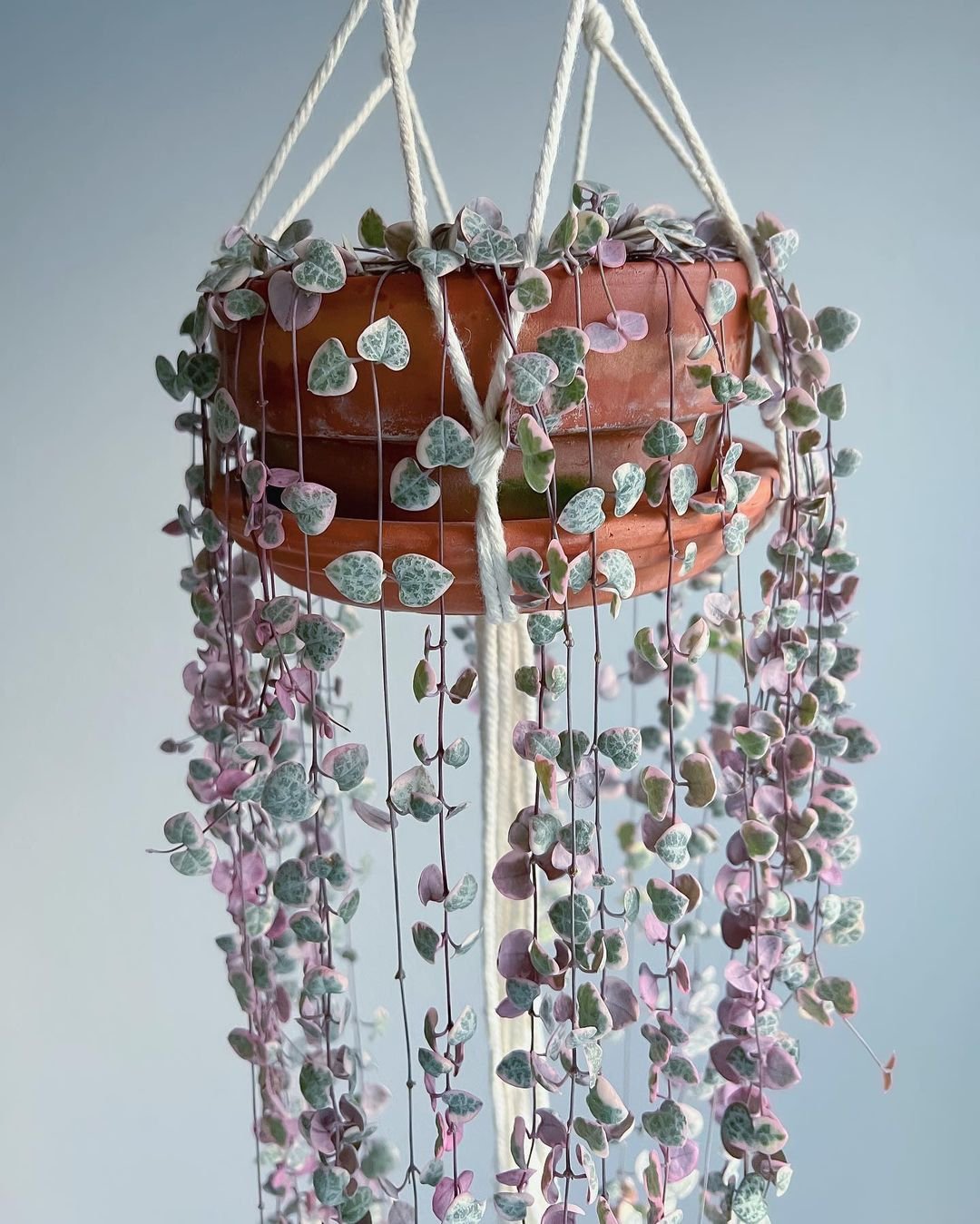
Here is an information chart for String of Hearts:
| Category | Details |
|---|---|
| Botanical Name | Ceropegia woodii |
| Common Name | String of Hearts, Rosary Vine |
| Plant Name | String of Hearts |
| Zone | USDA zones 10-12 |
| Sun Exposure | Bright, indirect light |
| Soil Type | Well-draining, sandy or cactus mix |
| Watering | Infrequent; allow soil to dry out between waterings |
| Growth Habit | Trailing vine |
| Height/Spread | 2-4 feet long trailing stems |
| Special Features | Drought-tolerant, heart-shaped leaves, easy to propagate |
This delicate vine has heart-shaped leaves on thin, purple stems.
Care tips:
- Light: Bright indirect light
- Water: Allow soil to dry between waterings
- Humidity: Average
Learn more about String of Hearts care
8. Philodendron
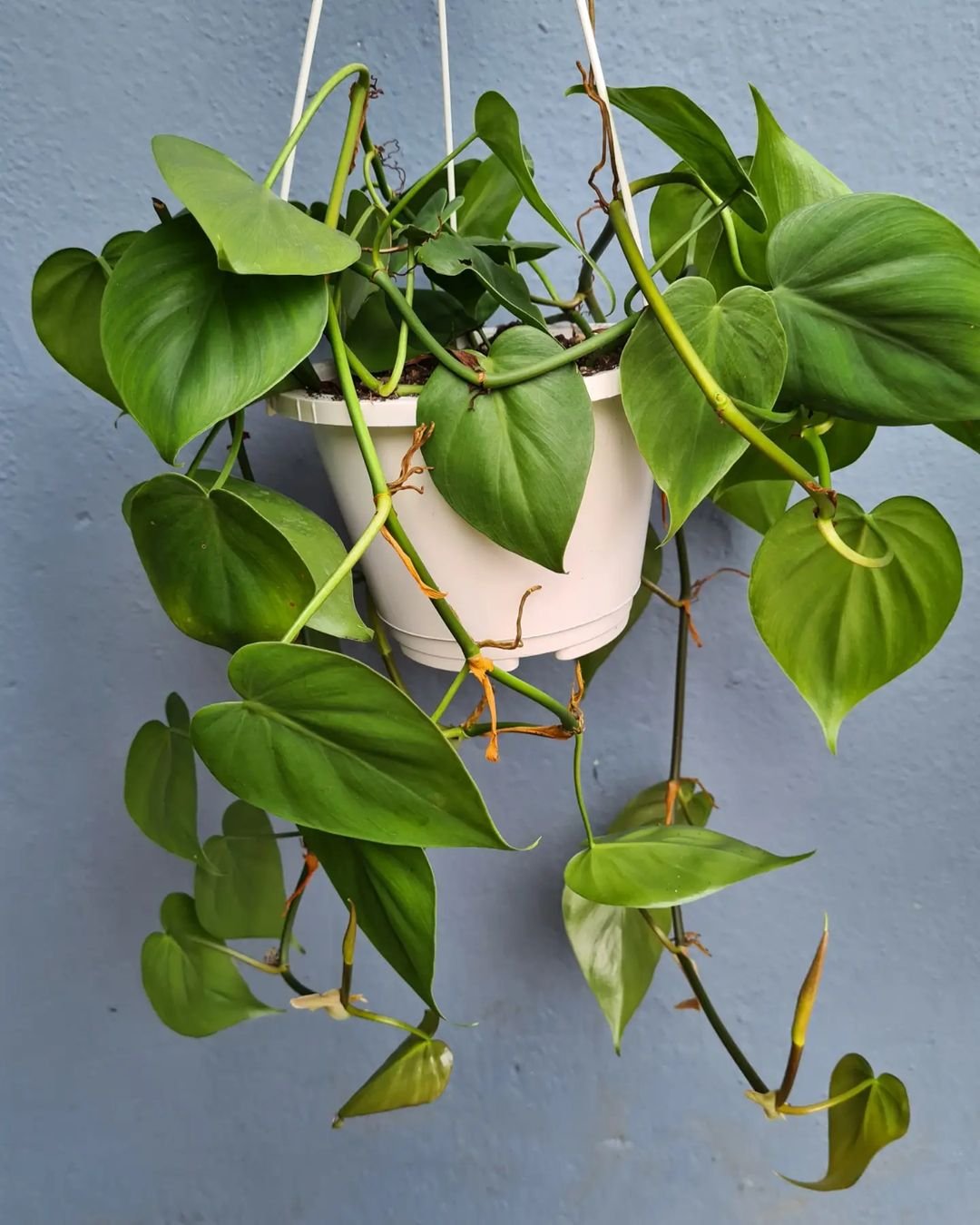
Here is an information chart for Philodendron:
| Category | Details |
|---|---|
| Botanical Name | Philodendron spp. |
| Common Name | Philodendron |
| Plant Name | Philodendron |
| Zone | USDA zones 9-11 |
| Sun Exposure | Bright, indirect light |
| Soil Type | Well-draining, rich and moist soil |
| Watering | Moderate; keep soil evenly moist but not waterlogged |
| Growth Habit | Climbing or trailing vine |
| Height/Spread | 1-20 feet tall, 1-6 feet wide, depending on species and variety |
| Special Features | Air-purifying, easy to grow, tolerates low light |
There are many types of trailing Philodendrons, all of which make great hanging plants.
Care tips:
- Light: Low to bright indirect light
- Water: Allow top inch of soil to dry between waterings
- Humidity: Average to high
Learn more about Philodendron care
9. Tradescantia
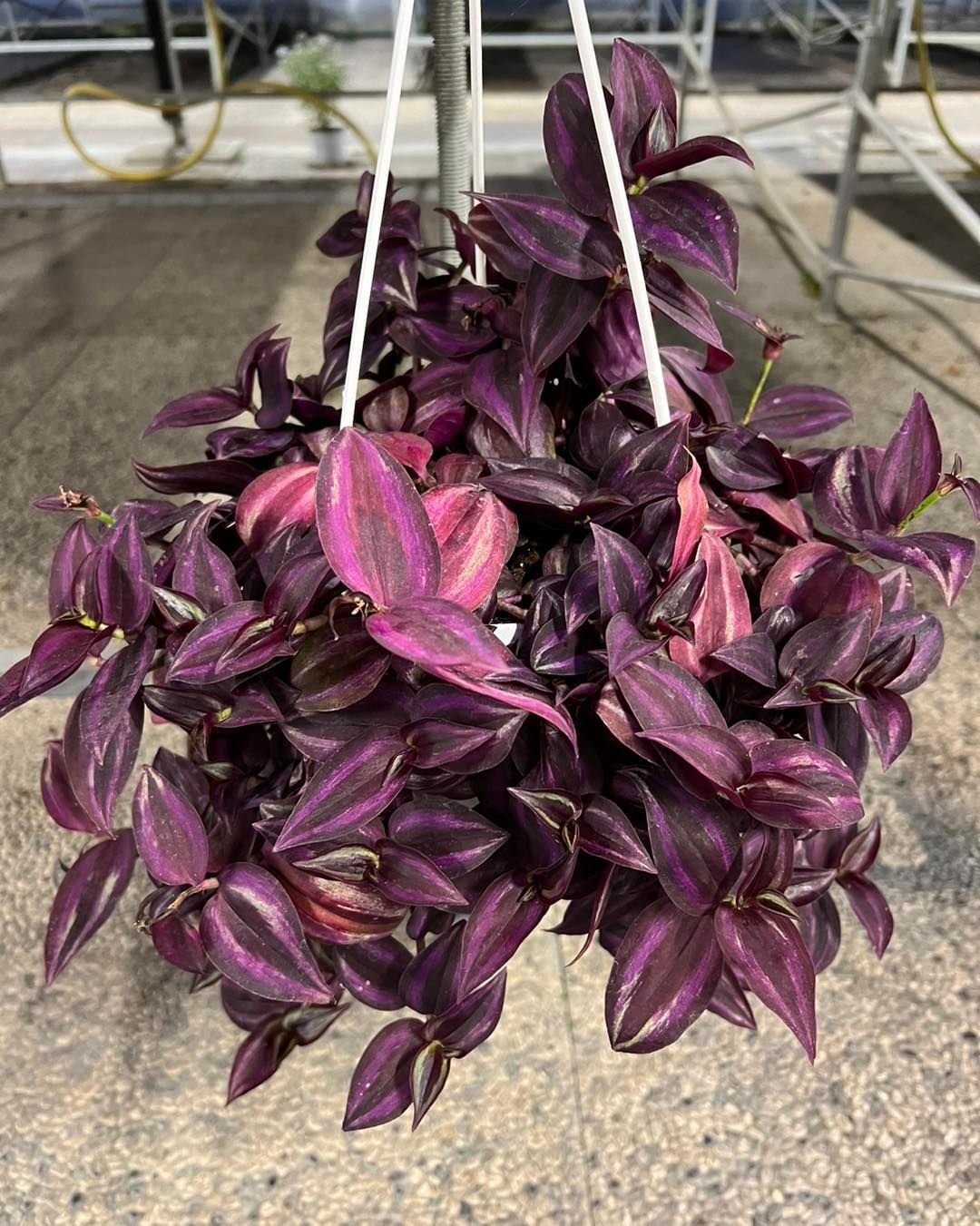
Here is an information chart for Tradescantia:
| Category | Details |
|---|---|
| Botanical Name | Tradescantia spp. |
| Common Name | Spiderwort, Wandering Jew |
| Plant Name | Tradescantia |
| Zone | USDA zones 8-12 |
| Sun Exposure | Bright, indirect light to partial shade |
| Soil Type | Well-draining, rich and moist soil |
| Watering | Moderate; keep soil evenly moist but not waterlogged |
| Growth Habit | Trailing or clumping |
| Height/Spread | 6-12 inches tall, 12-24 inches wide |
| Special Features | Fast-growing, colorful foliage, easy to propagate |
Also known as Wandering Jew, these plants have colorful, striped leaves.
Care tips:
- Light: Bright indirect light
- Water: Keep soil lightly moist
- Humidity: Average to high
Learn more about Tradescantia care
10. Lipstick Plant
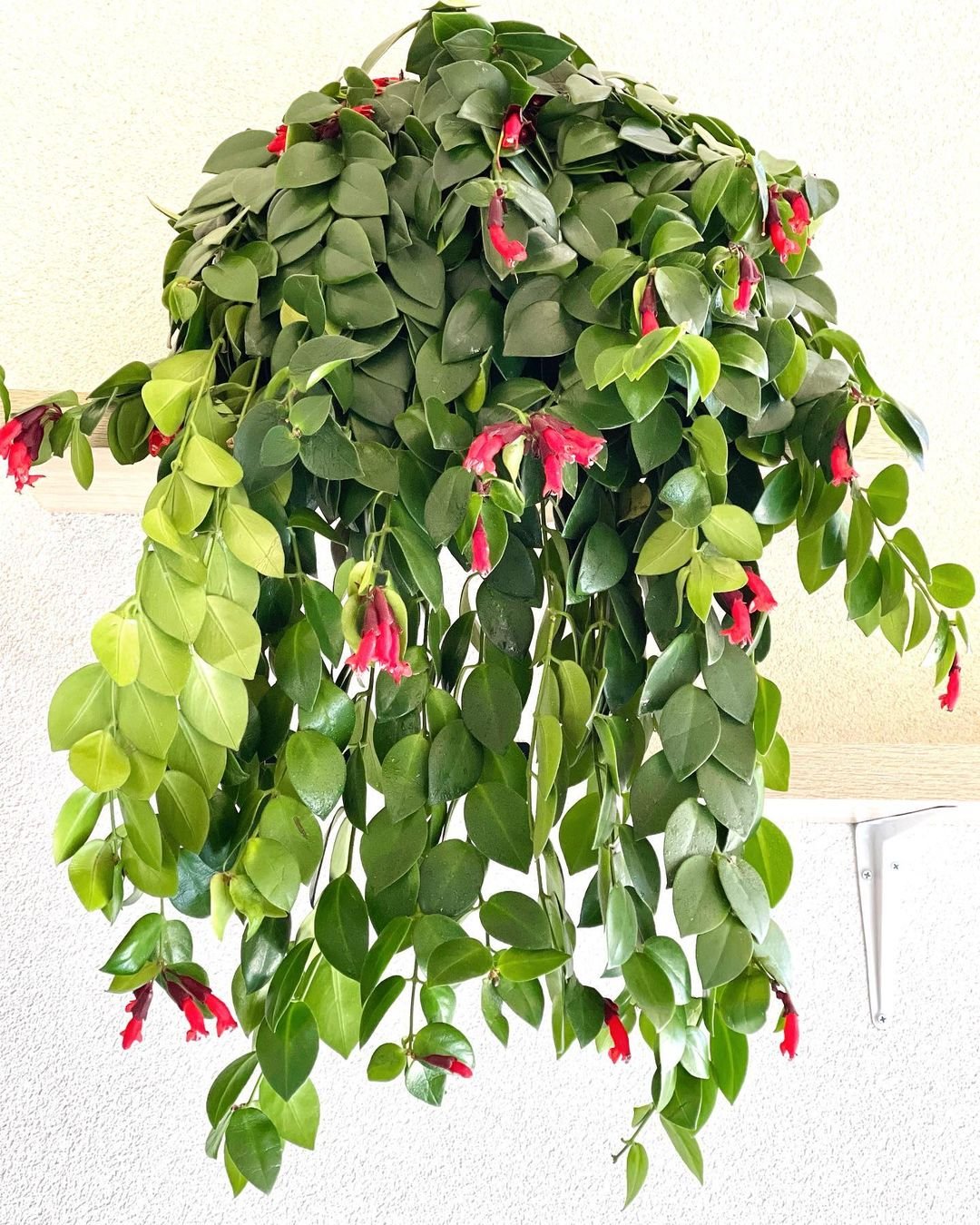
Here is an information chart for the Lipstick Plant:
| Category | Details |
|---|---|
| Botanical Name | Aeschynanthus radicans |
| Common Name | Lipstick Plant |
| Plant Name | Lipstick Plant |
| Zone | USDA zones 10-11 |
| Sun Exposure | Bright, indirect light |
| Soil Type | Well-draining, rich and moist soil |
| Watering | Moderate; keep soil evenly moist but not waterlogged |
| Growth Habit | Trailing or arching |
| Height/Spread | 1-2 feet long trailing stems |
| Special Features | Attractive tubular red flowers, easy to grow indoors, ornamental foliage |
Known for its bright red flowers that resemble lipstick tubes.
Care tips:
- Light: Bright indirect light
- Water: Allow top inch of soil to dry between waterings
- Humidity: High
Learn more about Lipstick Plant care
11. String of Bananas
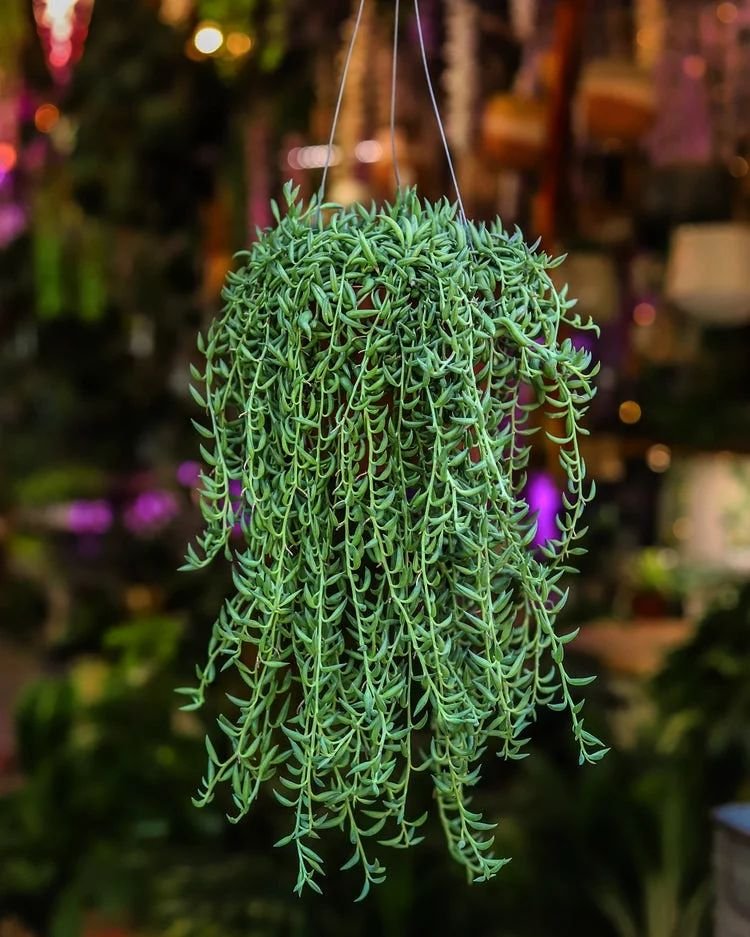
Here is an information chart for the String of Bananas:
| Category | Details |
|---|---|
| Botanical Name | Senecio radicans |
| Common Name | String of Bananas, Fishhook Senecio |
| Plant Name | String of Bananas |
| Zone | USDA zones 9-12 |
| Sun Exposure | Bright, indirect light to partial sun |
| Soil Type | Well-draining, sandy or cactus mix |
| Watering | Infrequent; allow soil to dry out between waterings |
| Growth Habit | Trailing succulent |
| Height/Spread | 2-3 feet long trailing stems |
| Special Features | Drought-tolerant, easy to propagate, unique banana-shaped foliage |
Similar to String of Pearls, but with banana-shaped leaves.
Care tips:
- Light: Bright indirect light
- Water: Allow soil to dry between waterings
- Humidity: Low to average
Learn more about String of Bananas care
12. Hoya (Hoya carnosa)

Here is an information chart for Hoya:
| Category | Details |
|---|---|
| Botanical Name | Hoya spp. |
| Common Name | Wax Plant, Hoya |
| Plant Name | Hoya |
| Zone | USDA zones 10-12 |
| Sun Exposure | Bright, indirect light |
| Soil Type | Well-draining, orchid bark mix or cactus mix |
| Watering | Moderate; allow soil to dry out between waterings |
| Growth Habit | Vining or trailing |
| Height/Spread | 1-3 feet long as a trailing vine, can be trained to climb |
| Special Features | Fragrant, star-shaped flowers, thick waxy leaves, easy to grow indoors, air-purifying |
Also known as Wax Plant, Hoyas have thick, waxy leaves and beautiful flowers.
Care tips:
- Light: Bright indirect light
- Water: Allow soil to dry between waterings
- Humidity: Average to high
13. Staghorn Fern (Platycerium bifurcatum)

Here is an information chart for the Staghorn Fern:
| Category | Details |
|---|---|
| Botanical Name | Platycerium spp. |
| Common Name | Staghorn Fern |
| Plant Name | Staghorn Fern |
| Zone | USDA zones 9-12 |
| Sun Exposure | Bright, indirect light to partial shade |
| Soil Type | Epiphytic; typically mounted on wood or grown in a well-draining mix such as orchid bark |
| Watering | Moderate; water when the growing medium is dry, mist regularly |
| Growth Habit | Epiphytic, grows on trees or mounts |
| Height/Spread | 2-3 feet tall and wide, depending on species |
| Special Features | Unique antler-like fronds, epiphytic growth habit, excellent for mounting on boards or hanging baskets |
This unique fern grows on a mount rather than in soil, making it a striking hanging plant.
Care tips:
- Light: Bright indirect light
- Water: Soak mount once a week
- Humidity: High
Learn more about Staghorn Fern care
14. String of Turtles

Here is an information chart for the String of Turtles:
| Category | Details |
|---|---|
| Botanical Name | Peperomia prostrata |
| Common Name | String of Turtles |
| Plant Name | String of Turtles |
| Zone | USDA zones 10-12 |
| Sun Exposure | Bright, indirect light |
| Soil Type | Well-draining, peat-based soil mix |
| Watering | Moderate; allow the top inch of soil to dry out between waterings |
| Growth Habit | Trailing, creeping |
| Height/Spread | 1-2 inches tall, trailing stems up to 12-18 inches long |
| Special Features | Unique patterned leaves resembling turtle shells, easy to grow indoors, compact and decorative |
This adorable plant has small, round leaves that resemble turtle shells.
Care tips:
- Light: Bright indirect light
- Water: Allow soil to dry between waterings
- Humidity: Average to high
Learn more about String of Turtles care
15. Bird’s Nest Fern

Here is an information chart for the Bird’s Nest Fern:
| Category | Details |
|---|---|
| Botanical Name | Asplenium nidus |
| Common Name | Bird’s Nest Fern |
| Plant Name | Bird’s Nest Fern |
| Zone | USDA zones 9-12 |
| Sun Exposure | Bright, indirect light to partial shade |
| Soil Type | Well-draining, rich and moist soil |
| Watering | Keep soil consistently moist, but not waterlogged |
| Growth Habit | Rosette forming, upright |
| Height/Spread | 2-4 feet tall and wide |
| Special Features | Glossy, wavy fronds, air-purifying, thrives in humid environments |
This fern has wide, rippled fronds that grow in a rosette shape.
Care tips:
- Light: Low to bright indirect light
- Water: Keep soil consistently moist
- Humidity: High
Learn more about Bird’s Nest Fern care
16. String of Dolphins
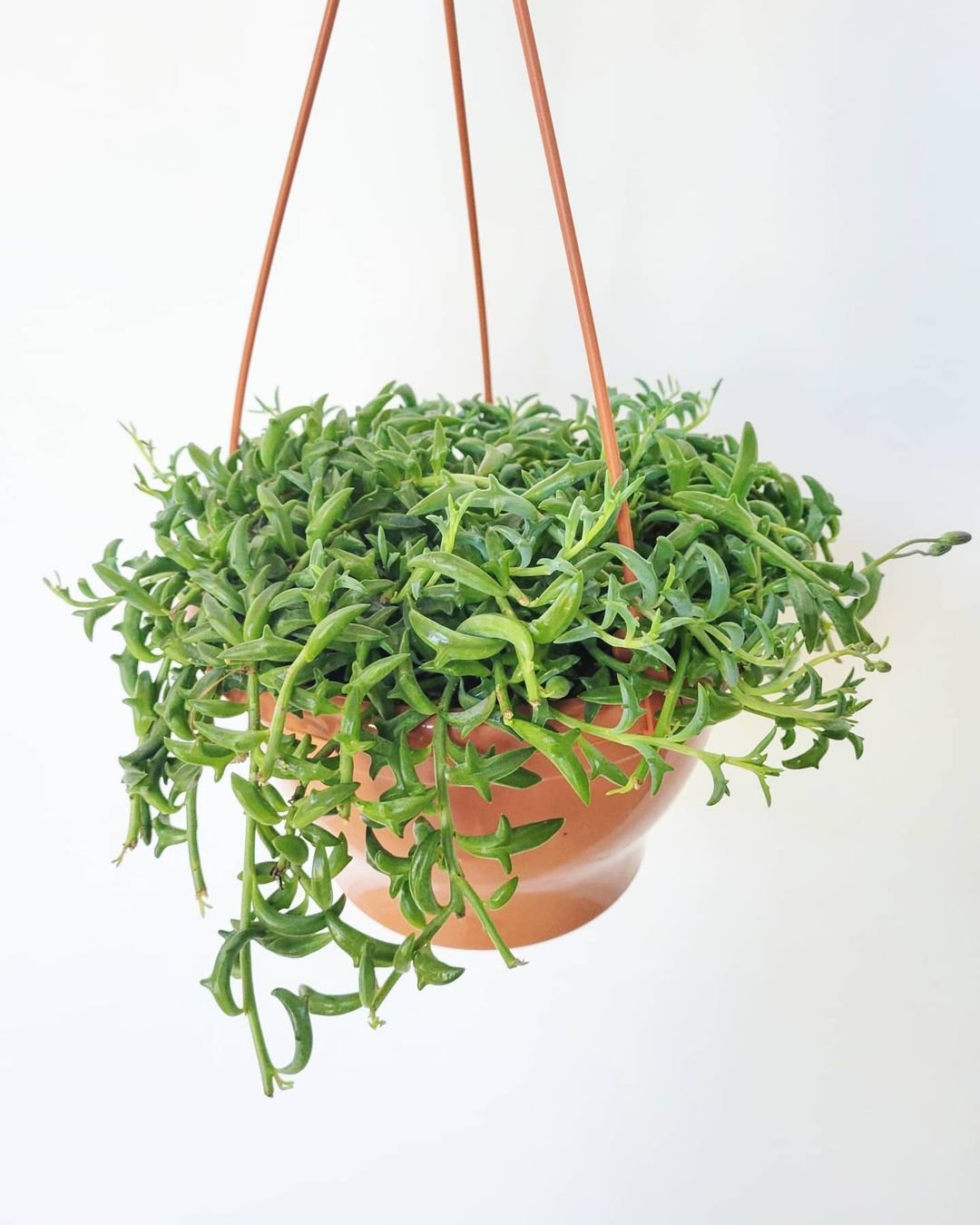
Here is an information chart for the String of Dolphins:
| Category | Details |
|---|---|
| Botanical Name | Senecio peregrinus |
| Common Name | String of Dolphins |
| Plant Name | String of Dolphins |
| Zone | USDA zones 10-12 |
| Sun Exposure | Bright, indirect light to partial sun |
| Soil Type | Well-draining, sandy or cactus mix |
| Watering | Infrequent; allow soil to dry out between waterings |
| Growth Habit | Trailing succulent |
| Height/Spread | 6 inches tall, trailing stems up to 1-2 feet long |
| Special Features | Unique dolphin-shaped leaves, drought-tolerant, easy to propagate |
The leaves of this plant look like tiny jumping dolphins!
Care tips:
- Light: Bright indirect light
- Water: Allow soil to dry between waterings
- Humidity: Low to average
Learn more about String of Dolphins care
17. Trailing Jade
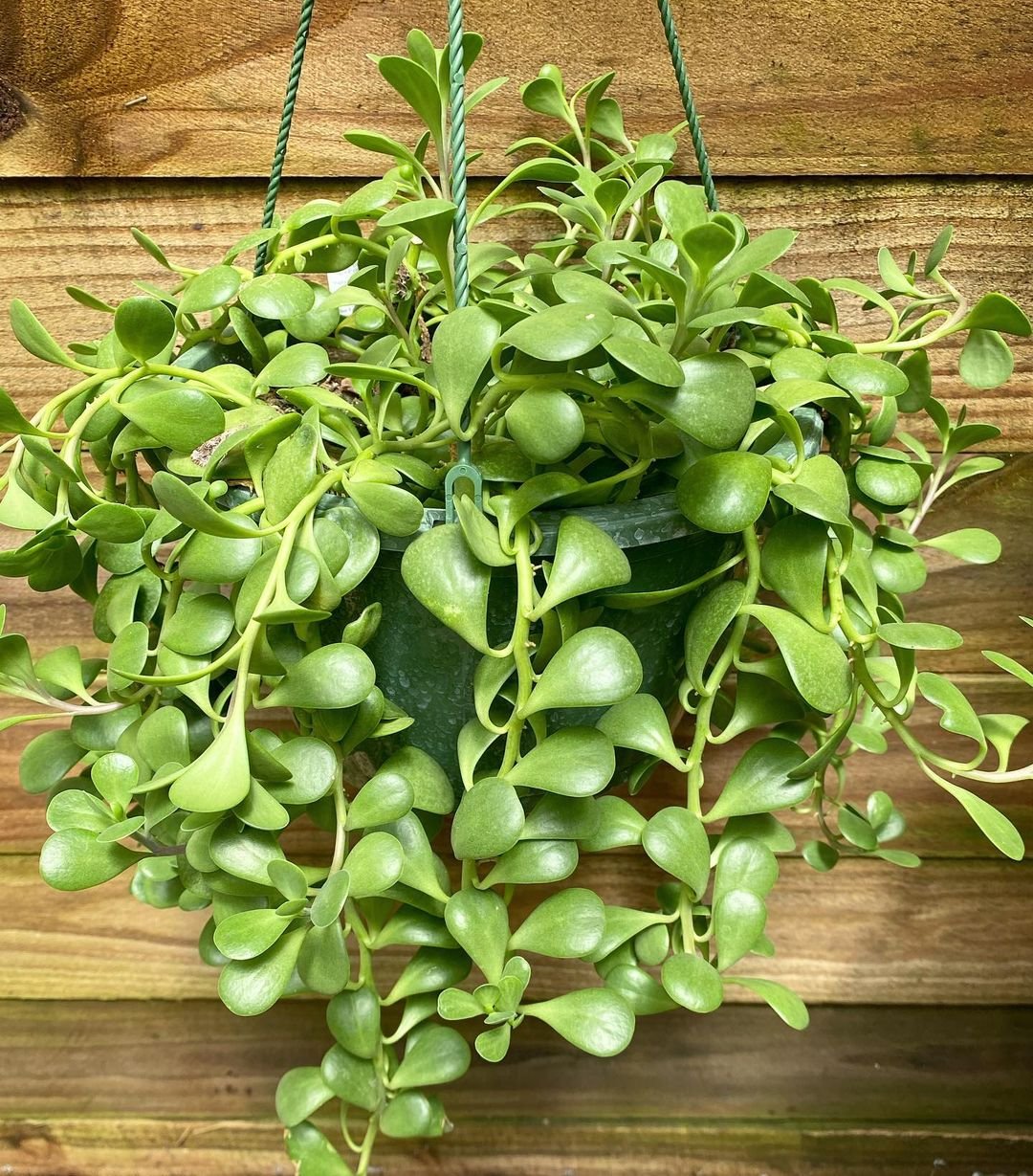
Here is an information chart for the Trailing Jade:
| Category | Details |
|---|---|
| Botanical Name | Peperomia rotundifolia |
| Common Name | Trailing Jade, Round Leaf Peperomia |
| Plant Name | Trailing Jade |
| Zone | USDA zones 10-12 |
| Sun Exposure | Bright, indirect light |
| Soil Type | Well-draining, peat-based or cactus mix |
| Watering | Moderate; allow the top inch of soil to dry out between waterings |
| Growth Habit | Trailing, creeping |
| Height/Spread | 4-6 inches tall, trailing stems up to 12-24 inches long |
| Special Features | Small, round leaves, easy to grow indoors, compact and decorative |
This plant has small, round leaves on trailing stems.
Care tips:
- Light: Bright indirect light
- Water: Allow soil to dry between waterings
- Humidity: Average
Learn more about Trailing Jade care
18. Hindu Rope Plant
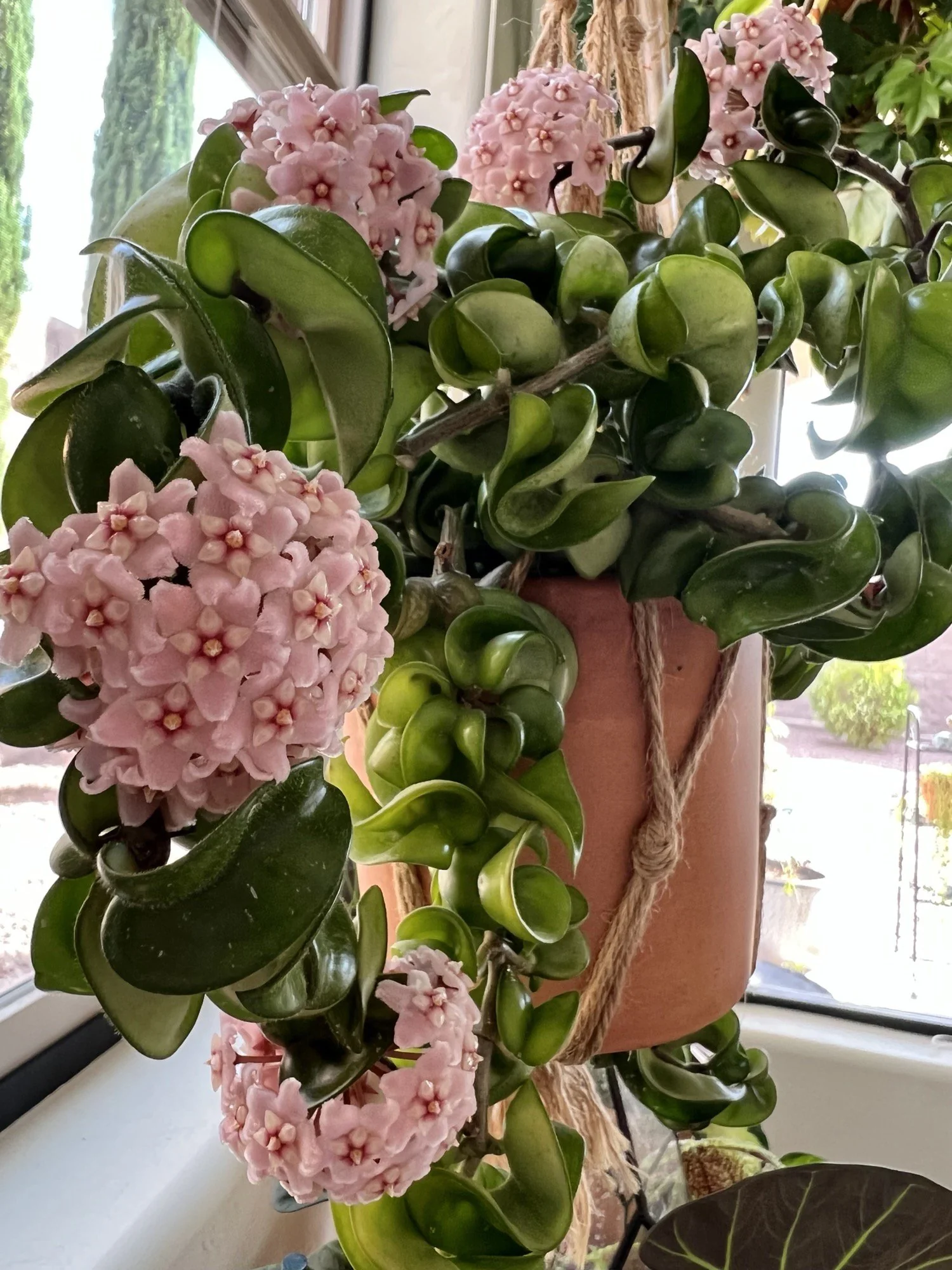
Here is an information chart for the Hindu Rope Plant:
| Category | Details |
|---|---|
| Botanical Name | Hoya carnosa compacta |
| Common Name | Hindu Rope Plant, Krinkle Kurl |
| Plant Name | Hindu Rope Plant |
| Zone | USDA zones 10-12 |
| Sun Exposure | Bright, indirect light |
| Soil Type | Well-draining, orchid bark mix or cactus mix |
| Watering | Moderate; allow soil to dry out between waterings |
| Growth Habit | Vining or trailing |
| Height/Spread | 1-2 feet long trailing stems |
| Special Features | Twisted, curly leaves, fragrant star-shaped flowers, drought-tolerant, easy to grow indoors |
This Hoya variety has curled, rope-like leaves.
Care tips:
- Light: Bright indirect light
- Water: Allow soil to dry between waterings
- Humidity: Average to high
Learn more about Hindu Rope Plant care
19. Neon Pothos
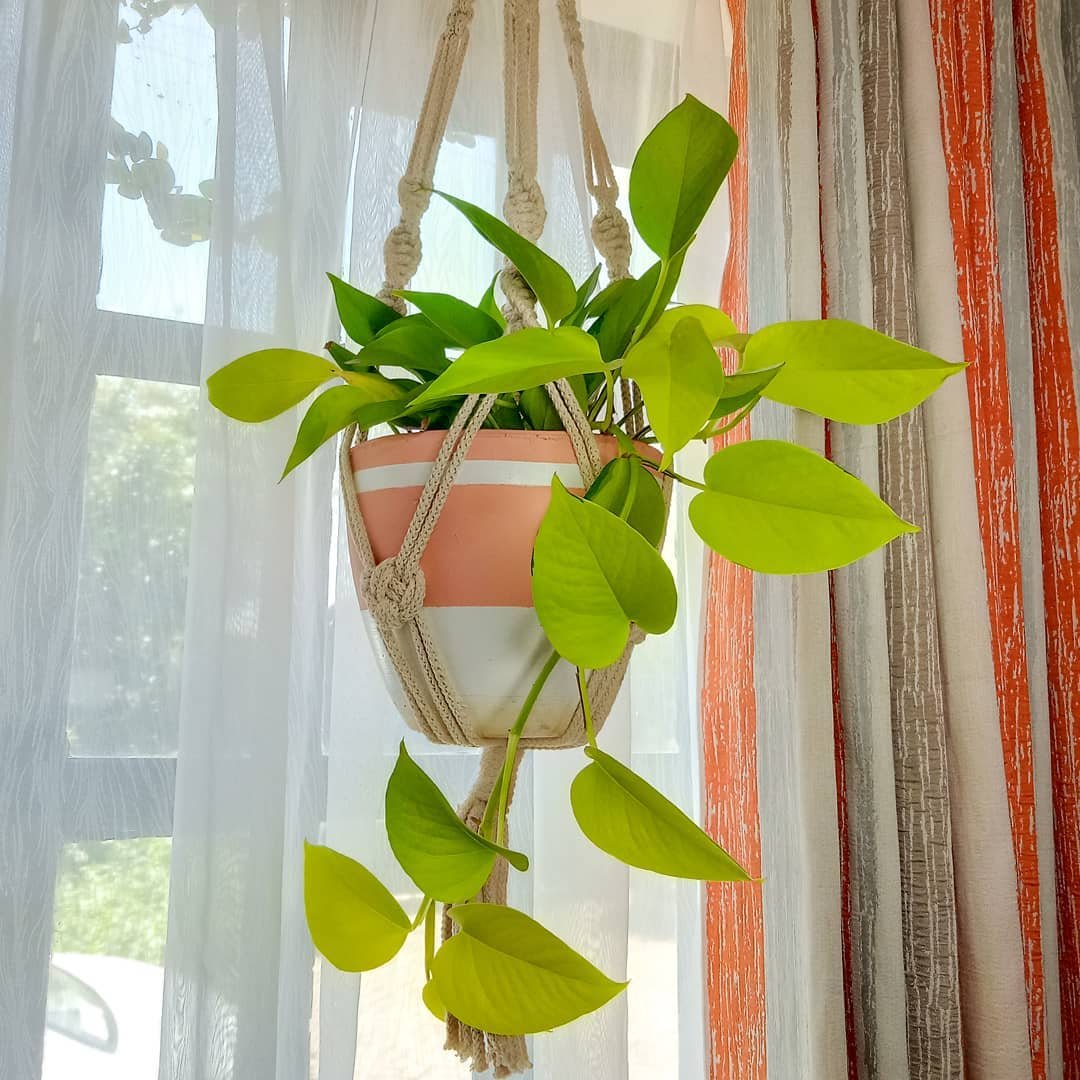
Here is an information chart for the Neon Pothos:
| Category | Details |
|---|---|
| Botanical Name | Epipremnum aureum ‘Neon’ |
| Common Name | Neon Pothos |
| Plant Name | Neon Pothos |
| Zone | USDA zones 10-12 |
| Sun Exposure | Bright, indirect light to low light |
| Soil Type | Well-draining, all-purpose potting mix |
| Watering | Moderate; allow the top inch of soil to dry out between waterings |
| Growth Habit | Trailing or climbing vine |
| Height/Spread | 6-10 feet long as a trailing vine, can be trained to climb |
| Special Features | Bright, neon-green leaves, easy to grow, air-purifying |
A bright, lime-green variety of the classic Pothos.
Care tips:
- Light: Bright indirect light
- Water: Allow soil to dry between waterings
- Humidity: Adapts to average home humidity
Learn more about Neon Pothos care
20. String of Nickels
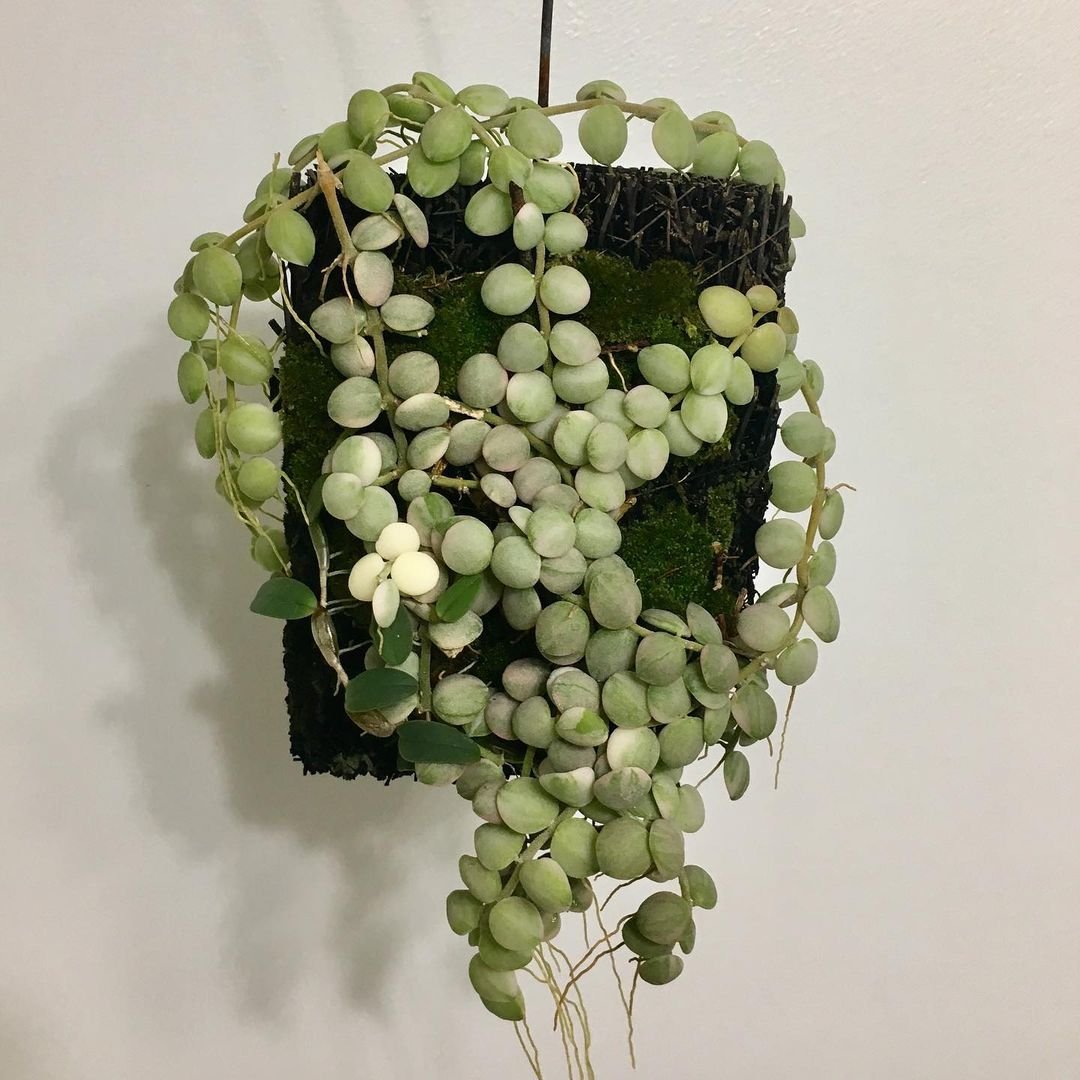
Here is an information chart for the String of Nickels:
| Category | Details |
|---|---|
| Botanical Name | Dischidia nummularia |
| Common Name | String of Nickels |
| Plant Name | String of Nickels |
| Zone | USDA zones 10-11 |
| Sun Exposure | Bright, indirect light |
| Soil Type | Well-draining, orchid bark or succulent mix |
| Watering | Moderate; allow soil to dry out slightly between waterings |
| Growth Habit | Trailing or cascading |
| Height/Spread | 1-3 feet long trailing stems |
| Special Features | Small, round leaves resembling nickels, epiphytic growth habit, easy to grow indoors |
This unique plant has small, round leaves that resemble coins.
Care tips:
- Light: Bright indirect light
- Water: Allow soil to dry between waterings
- Humidity: High
Learn more about String of Nickels care
There you have it – our top 20 best hanging plants to grow in 2024! Whether you prefer lush, trailing vines or unique succulents, there’s a hanging plant out there for everyone. Remember, the key to success with any plant is understanding its needs and providing the right care.
Here are some general tips for caring for hanging plants:
- Check the weight: Make sure your hanging apparatus can support the weight of the plant, pot and wet soil.
- Rotate regularly: Turn your plant every few weeks to ensure even growth.
- Watch for pests: Hanging plants can be more susceptible to pests, so check them regularly.
- Consider ease of watering: Choose a pot with good drainage and a method of watering that works for you.
For more information on plant care, check out these resources:
- University of Vermont Extension: Houseplant Care
- Missouri Botanical Garden: Indoor Plants
- Cornell University: Houseplant Care
Happy planting and enjoy your beautiful hanging gardens!
Pingback: 10 Awesome Hanging Succulents to Cool Up Your Place
Pingback: Repurposed Undergarments as Plant Pots: A Quirky and Sustain